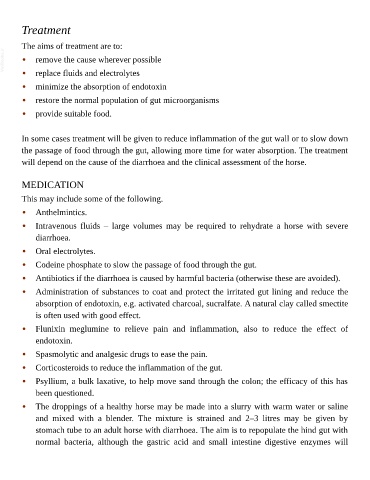Page 782 - The Veterinary Care of the Horse
P. 782
Treatment
The aims of treatment are to:
VetBooks.ir • remove the cause wherever possible
• replace fluids and electrolytes
• minimize the absorption of endotoxin
• restore the normal population of gut microorganisms
• provide suitable food.
In some cases treatment will be given to reduce inflammation of the gut wall or to slow down
the passage of food through the gut, allowing more time for water absorption. The treatment
will depend on the cause of the diarrhoea and the clinical assessment of the horse.
MEDICATION
This may include some of the following.
• Anthelmintics.
• Intravenous fluids – large volumes may be required to rehydrate a horse with severe
diarrhoea.
• Oral electrolytes.
• Codeine phosphate to slow the passage of food through the gut.
• Antibiotics if the diarrhoea is caused by harmful bacteria (otherwise these are avoided).
• Administration of substances to coat and protect the irritated gut lining and reduce the
absorption of endotoxin, e.g. activated charcoal, sucralfate. A natural clay called smectite
is often used with good effect.
• Flunixin meglumine to relieve pain and inflammation, also to reduce the effect of
endotoxin.
• Spasmolytic and analgesic drugs to ease the pain.
• Corticosteroids to reduce the inflammation of the gut.
• Psyllium, a bulk laxative, to help move sand through the colon; the efficacy of this has
been questioned.
• The droppings of a healthy horse may be made into a slurry with warm water or saline
and mixed with a blender. The mixture is strained and 2–3 litres may be given by
stomach tube to an adult horse with diarrhoea. The aim is to repopulate the hind gut with
normal bacteria, although the gastric acid and small intestine digestive enzymes will

